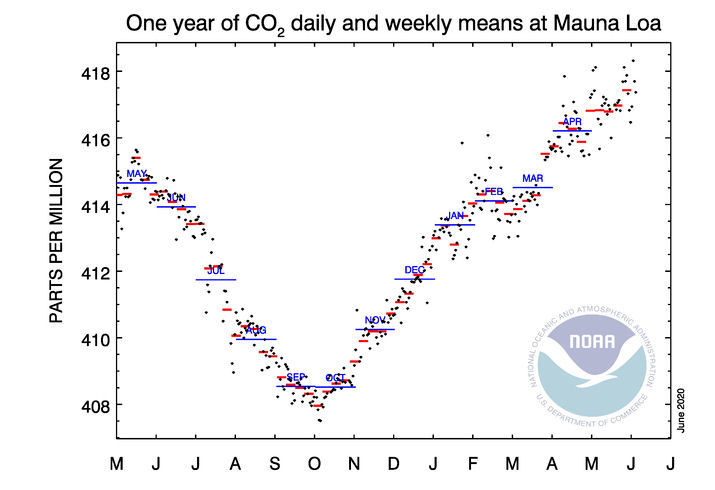An estimation of the human influence on the climate

06/05/2020 12:33 - Posted by Tom van Leeuwen
The month of May has come to an end. Another month of economic paralysis and reduced human CO
2 emissions. And again, the CO
2 concentration in the atmosphere continues to rise to record levels in modern measurements.
It is time to remove the blindfolds and thoroughly analyze the question of the effect of human CO
2 emissions on global temperature. I propose to divide the problem into four issues, open for discussion:
1. The influence of humanity on the carbon cycle.
The carbon cycle includes the absorption and respiration of flora and fauna, the oceans and human emissions. These are the three most important factors. The empirical data from the last 3 months (march - may 2020) shows us that the human factor is much less important than we used to think. My estimate: only 10% of the CO
2 increase is caused by human emissions.
2. CO
2 as a greenhouse gas.
CO
2 is one of the greenhouse gases. This means that it has the ability to absorb some frequencies of infrared radiation emitted by the Earth, slowing down its surface cooling. But, taking into account the absorbed electromagnetic frequency bands, their overlap with the water vapor absorption bands, the degree of saturation of their absorption bands and the band broadening (which slightly increases the effect), my estimate is that CO
2 is causing only 10% of the total greenhouse effect of the Earth's atmosphere.
3. Water vapor.
The alarmist climate models, recognizing point 2, are largely based on the positive feedback effect of water vapor caused by CO
2. They imply that a small change in CO
2 causes a big change in the effect for H
2O. The problem here is that the same models do not take into account the complexity of the effect of water vapor on the climate. H
2O as a greenhouse gas is active in both the infrared and ultraviolet bands. This means that H
2O also absorbs radiation from the sun, causing cooling. In addition, water vapor condenses, forming clouds that reflect sunlight, cooling the surface. Therefore, it is not at all clear whether this feedback effect is positive or negative.
4. Other factors.
Looking at broader time scales, no correlation is observed between CO
2 and global temperature. Other factors, such as the shape of the Earth's orbit around the Sun, the inclination of the Earth's axis, solar activity, ocean currents,... all have their periodicity and the effects of these cycles are superimposed one on another. The greenhouse effect is, among these predominant factors, a very small factor, especially when the it is mostly saturated, as is the case during the interglacials. After observing the empirical measurements from the past, my estimation is that no more than 10% of the current climate variations is caused by greenhouse gases.
So, my estimation is that the total influence of humanity on the climate is (10% of 10% of 10%) at most 1/1000 part (0.1%) of all factors.
In addition, taking into account the great unknown of point 3 (water vapor, this factor can be positive or negative) we cause between 0.1% heating and 0.1% cooling.
This is my estimate. The IPCC assesses that most of the modern warming is due to human activities. But they never proved that. It's their estimate. I would really like to see their scientific reasoning and replicable experimental proofs to back their claims that I'm off by that far for every one of the four points I've set out in this article.
Conclusion: we urgently need replicable proofs of the following:
1. The impact of human activities on the CO
2 concentration
2. The impact of CO
2 on the greenhouse effect
3. The impact of variations in water vapor on the average temperature
4. The impact of the greenhouse effect on climate, compared to the other factors.
Until these point have been scientifically determined, all government "climate action" should be suspended.
Tom van Leeuwen, June 4, 2020.
